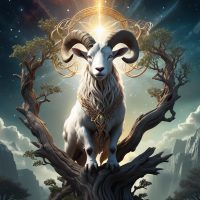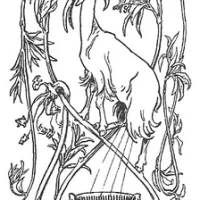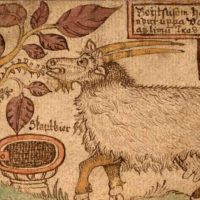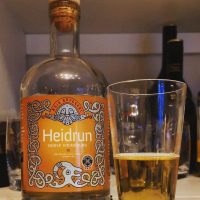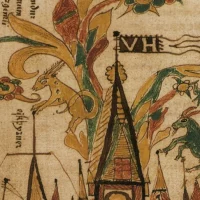Heidrun : The Mead Maker
Listen
At a glance
| Description | |
|---|---|
| Origin | Norse Mythology |
| Classification | Animals |
| Family Members | N/A |
| Region | Iceland, Norway, Denmark |
| Associated With | Mead |
Heidrun
Introduction
Heidrun, or Heiðrún in Old Norse, hails from the mythological realm of Norse mythology. This mythical being calls Valhalla, the grand hall of the gods in Asgard, her home. Etymologically, Heidrun’s name combines “heið,” meaning bright or clear, and “rún,” suggesting secrecy or mystery, encapsulating the enigmatic essence of this creature. Far from a deity or warrior, Heidrun is a mysterious goat whose significance in Norse culture transcends her humble appearance. Delving into her story reveals layers of symbolism that illuminate both the practical and profound aspects of Norse belief. Amidst the pantheon of fearsome wolves and majestic ravens, Heidrun stands as a humble yet extraordinary figure within Valhalla’s sacred halls.
Physical Traits
Heidrun’s portrayal in Norse texts is rather scant, yet a prevalent image depicts her as a sizable nanny goat. Artists often depict her atop Valhalla’s roof, the esteemed hall where fallen warriors, the Einherjar, dwell post-battle. Notably, there are no fantastical attributes attributed to her – Heidrun’s prowess transcends physicality to manifest in her mystical abilities. She is renowned for her capacity to produce unending quantities of mead, a sacred elixir, from her udders.
This beverage holds profound significance within Norse culture, symbolizing vitality and divine essence. In Norse lore, Heidrun is envisioned as a striking figure atop Yggdrasil, the World Tree, symbolizing abundance and sustenance. Her gleaming white fur symbolizes purity and vitality, reflecting her role as a source of nourishment. As she consumes the tree’s leaves, she transforms them into the divine mead that sustains the gods in their eternal revelry.
Family
Although Norse myths lack explicit details regarding Heidrun’s familial ties, her solitary presence atop Valhalla implies her independence from a herd. Her closest companion is Eikthyrnir, the stag that grazes on Yggdrasil’s leaves alongside her. While Norse texts don’t specify Heidrun’s family, she shares Valhalla’s roof with the Einherjar, warriors who perished in battle for Odin. Moreover, Heidrun’s connection to the universe’s foundational forces is evident as she feeds on Yggdrasil’s leaves, the World Tree. Mythologically, she is believed to descend from Audhumbla, the cosmic cow whose actions birthed the first Norse god, Buri. This lineage underscores Heidrun’s significance within the mythological hierarchy, tying her to the very genesis of the Norse pantheon.
Other names
Heidrun, the celestial goat of Norse mythology, is commonly known by various names that reflect her divine essence. While “Heidrun” is the most recognized, she is also referred to as Eikþyrnir, translating to “oak-thorny” or “oak-piercer.” This alternate name suggests her profound connection to the sacred tree, emphasizing her celestial nature. Additionally, Heidrun’s name undergoes various anglicizations, including Heidhrun, Heithrun, Heidrún, Heithrún, or Heidhrún. Etymologically, “Heidrun” originates from “heið,” meaning bright or clear, and “rún,” implying secrecy or mystery, encapsulating her enigmatic character.
Powers and Abilities
Heidrun possesses a remarkable ability to endlessly produce mead from her udders, a feat that holds significant importance in Norse mythology. This mead serves as both sustenance and drink for the fallen warriors, the Einherjar, who are escorted to Valhalla by the Valkyries following their deaths in battle. Heidrun’s existence symbolizes the profound significance that the Norse attributed to mead, transcending its role as a mere beverage to become a poetic symbol of inspiration and divine wisdom. Within Valhalla, Heidrun’s magical mead fills a colossal cauldron, sustaining the Einherjar as they prepare for the impending Ragnarok, the prophesied end of the world. The precise origin of this enchanted mead remains somewhat mysterious. While some scholars speculate that Heidrun’s consumption of Yggdrasil’s leaves grants her the ability to produce the divine beverage, others suggest that the mystical nature of Valhalla itself contributes to its endless flow.
Modern Day Influence
Heidrun’s impact stretches far beyond ancient Norse myth, leaving an imprint on modern culture. Amon Amarth, a Swedish melodic death metal band, titled one of their songs after her, while Agalloch, a metal band from Portland, Oregon, referenced Heidrun in their song “Not Unlike the Waves.” Beyond her role as a mere provider of sustenance, Heidrun embodies the concept of limitless abundance, vital for agrarian societies. Her endless flow of mead signifies eternal feasts for warriors in the afterlife, a testament to their bravery in battle. Additionally, her association with Yggdrasil, the world tree linking all realms, elevates her to a symbol of interconnectedness and life force throughout the cosmos.
Intriguingly, in the Hyndluljóð poem of the Poetic Edda, the giantess Hyndla uses “Heidrun” as an insult, suggesting broader connotations beyond its literal meaning, possibly implying “carelessness” or “wastefulness” in certain contexts. Heidrun’s presence endures in modern times, manifesting in various artistic expressions of Norse mythology, from visual arts to gaming and literature. Breweries have adopted her name for mead, honoring her legendary role as its provider.
Beyond art and libations, Heidrun embodies themes of hospitality and the cyclical nature of life, resonating with those who value tradition and myth’s enduring power. Despite centuries passing, Heidrun remains a compelling figure in contemporary culture, often appearing as a symbol of fertility, abundance, and mysticism in Norse-inspired works. Moreover, her role as a source of inspiration continues to captivate creators across diverse fields, echoing the timeless flow of creativity akin to the divine mead from her udders.
Related Images
Frequently Asked Questions
What is lorem Ipsum?
I am text block. Click edit button to change this text. Lorem ipsum dolor sit amet, consectetur adipiscing elit. Ut elit tellus, luctus nec ullamcorper mattis, pulvinar dapibus leo.
What is lorem Ipsum?
I am text block. Click edit button to change this text. Lorem ipsum dolor sit amet, consectetur adipiscing elit. Ut elit tellus, luctus nec ullamcorper mattis, pulvinar dapibus leo.
What is lorem Ipsum?
I am text block. Click edit button to change this text. Lorem ipsum dolor sit amet, consectetur adipiscing elit. Ut elit tellus, luctus nec ullamcorper mattis, pulvinar dapibus leo.
What is lorem Ipsum?
I am text block. Click edit button to change this text. Lorem ipsum dolor sit amet, consectetur adipiscing elit. Ut elit tellus, luctus nec ullamcorper mattis, pulvinar dapibus leo.
What is lorem Ipsum?
I am text block. Click edit button to change this text. Lorem ipsum dolor sit amet, consectetur adipiscing elit. Ut elit tellus, luctus nec ullamcorper mattis, pulvinar dapibus leo.

